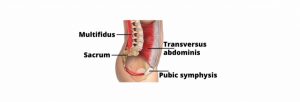Did you know? How you breathe affects your pelvic floor….
You can reduce the amount of pressure on your pelvic floor by the way you breathe. When you aren’t breathing correctly your pelvic floor is working overtime. This may cause the muscles to become tense or tight, which can lead to issues such as pelvic pain, urinary incontinence, and overactive bladder type symptoms. When you exhale, your pelvic floor will rise up and have a small contraction. When you aren’t able to exhale correctly, your pelvic floor may remain on a constant stretching from the pressure in the abdomen. This may lead to weakening of your pelvic floor, which causes urinary incontinence and prolapse. This is very important if you suffer from a variety of pelvic floor conditions, so read on to see if your breathing needs a tune-up!
Our diaphragm is our breathing muscle, and it attaches along our lower rib cage and thoracic spine. When it contracts it descends down our abdominal cavity allowing our lungs to inflate with air (i.e. breathe in). Therefore, depending on how we breathe there can be more or less pressure placed on our pelvic floor.
There are three different types of breathing patterns: Apical (or upper chest) breathing, diaphragmatic (or belly) breathing and lateral costal flaring (or side rib) breathing. The majority of people are either upper chest or belly breathers, but we actually want to be a combination of lateral costal flaring and diaphragmatic breathing; this way the pressures are dispersed out to the sides as well as downward. This is ideal for all women (and men) but is especially important for women who already have pelvic organ prolapse. Adopting this breathing pattern can help decrease the load the pelvic floor has to support, which in turn can help with symptoms related to prolapse.
So how do you re-teach yourself how to breathe?! 3 Great Exercises to get you started.
1) Bow & Arrow (or Arm Openings in Pilates) – this movement stretch promotes rotation through the thoracic spine and rib cage. In order to be able to breathe into your rib cage, it needs to be able to move. So while lying on your side keep your knees bent, arms out in front of you, then rotate your upper body in the opposite direction of your knees, aiming to get your top arm lying on the floor behind you.
2) Hands of breathing – the easiest way to know if you are breathing into your lateral rib cage while sitting or lying down place one hand on to your lower ribs and one on your tummy. When you take a breath in you want to feel the hand on your ribs move first and then the hand on your tummy. Remember we are looking for a combination of the two movements, so it does not have to be just the ribs moving.
3) Wrap a towel around your waist to give tactile feedback for lateral costal breathing. Similar to number 2, the towel gives you a target to breathe into. You can apply a small amount of resistance to help with this, but not too much that your ribs cannot move.
Questions? Ask our pelvic floor therapist, Chenoa Koke, for more information.






